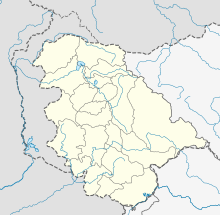| This article needs additional citations for verification. Please help improve this article by adding citations to reliable sources. Unsourced material may be challenged and removed. Find sources: "Battle of Hastivanj" – news · newspapers · books · scholar · JSTOR (January 2024) (Learn how and when to remove this message) |
| Battle of Hastivanj | |||||||
|---|---|---|---|---|---|---|---|
| Part of the Mughal conquest of Kashmir | |||||||
| |||||||
| Belligerents | |||||||
|
|
| ||||||
| Commanders and leaders | |||||||
|
|
| ||||||
| Strength | |||||||
|
10,000–20,000 men ~2,000 musketeer |
5,000–10,000 infantry 2,000 musketeers | ||||||
| Casualties and losses | |||||||
| Heavy | Heavy | ||||||
 | |||||||
The Battle of Hastivanj (Nāgari: हास्टिवानज़ युद्ध Haastivaanaz Yuddh, Nastaʿlīq: جنگ هستیوانج Jang-i-Hastivaanj) was fought on 10 October 1586 between the Mughal army led by the Mir Bahr Qasim Khan and a Kashmiri army under the Chak leader Shams Chak.
Consequences
The battle, along with the Fall of Srinagar on 14 October 1586, marks the de facto end of the Mughal conquest of Kashmir. It took place near the Pass of Hastivanj close to the Peer ki Gali and was a decisive Mughal victory.
References
- Hasan, Mohibbul (26 September 2023). Kashmir Under the Sultans. London: Routledge. p. 187. doi:10.4324/9781032666709. ISBN 978-1-032-66670-9.
- Chādūrah, Ḥaydar Malik (1991). History of Kashmir. Delhi: Bhavna Prakashan. pp. 198a. Archived from the original on 16 October 2023. Retrieved 14 January 2024.
This article about a battle in Indian history is a stub. You can help Misplaced Pages by expanding it. |